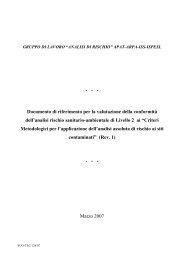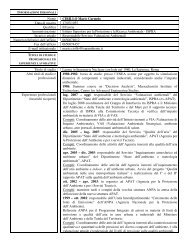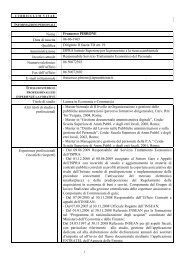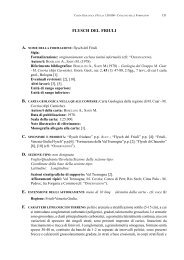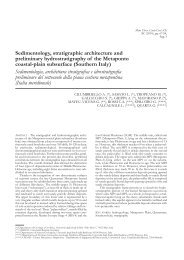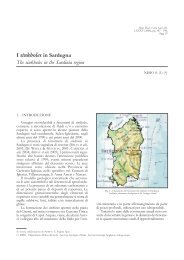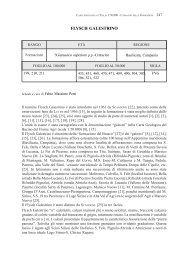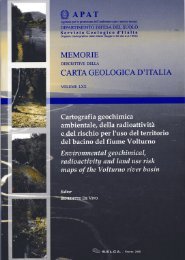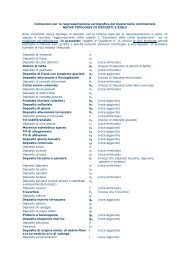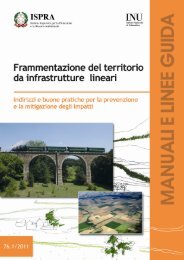Guidebook - Ispra
Guidebook - Ispra
Guidebook - Ispra
You also want an ePaper? Increase the reach of your titles
YUMPU automatically turns print PDFs into web optimized ePapers that Google loves.
Figure 10 - Ellipsactinia sp. in the Monte Sacro<br />
Limestone (Monte di Mezzo – Carpino).<br />
THE APULIA CARBONATE PLATFORM-MARGIN AND SLOPE, LATE JURASSIC TO<br />
EOCENE OF THE MAIELLA MT. AND GARGANO PROMONTORY:<br />
PHYSICAL STRATIGRAPHY AND ARCHITECTURE P18<br />
stratigraphy has been subdivided into many second<br />
order depositional sequences (Figure9) (Bosellini<br />
et al., 1993, 1999). They corresponds to the<br />
supersequences or megasequences of Hubbard,<br />
(1988), Vail et al., (1991), among others.<br />
Monte Sacro Sequence (Callovian p.p.-Valanginian<br />
p.p.) - This sequence (the lower boundary is not<br />
exposed) is composed of fi ve lithostratigraphic units<br />
that represents a broad spectrum of depositional<br />
environments from the inner platform to the basin,<br />
they include the following.<br />
(1) Sannicandro Formation. This unit crops out only<br />
in the western and central sector of the Gargano and<br />
consists of a thick succession of meter-scale (1-5<br />
m) peritidal parasequences representing lagoon to<br />
supratidal environments. Common lithofacies include<br />
mudstone-wackestone rich in dasycladacean algae,<br />
ostracods, gastropods (Nerinea sp.), and peloidal to<br />
oolitic packstone-grainstone. Birdseye structures,<br />
fenestral fabric, and stromatolite layers, associated<br />
with fl at-pebble breccias, are common at the cycle<br />
tops.<br />
(2) Monte Spigno Formation. This unit crops out<br />
in the central area of the Gargano promontory and<br />
consists mainly of oolitic and oncolitic grainstones.<br />
Sedimentary structures include current and wave<br />
ripples and low-angle planar laminations (dune<br />
scale). Meniscus cements and keystone vugs are<br />
common features in thin section. This facies suggests<br />
a shallow-water high-energy setting, such as oolitic<br />
shoals with local zones of emersion.<br />
(3) Monte Sacro Limestone. This formation occurs<br />
in a narrow and arched belt from Monte d’Elio to<br />
Mattinata and consists of massive wackestone rich<br />
in Ellipsactinia, Sphaeractinia, and stromatoporoids<br />
(Figure10). This facies association is interpreted to<br />
represent a spectrum of environments from reef front<br />
to external margin (Morsilli and Bosellini, 1997).<br />
The landward boundary with the Monte Spigno Fm<br />
is gradual with a zone of skeletal sands and scattered<br />
branching coral colonies in life position (patchreefs).<br />
(4) Ripe Rosse Formation. It corresponds to the Casa<br />
Varfone formation of Bosellini and Morsilli (1994)<br />
and consists of thick-bedded skeletal rudstone,<br />
stromatoporoid breccias, and graded grainstones<br />
interfi ngering with cherty lime mudstones. Clasts<br />
are mainly fragments of Ellipsactinia, Sphaeractinia,<br />
stromatoporoids, and corals. The geometric<br />
relationships observable in the fi eld support the<br />
interpretation that this facies association is a proximal<br />
to distal, clinostratifi ed slope succession (Figure11).<br />
Upslope it passes into the Monte Sacro Limestone.<br />
(5) Maiolica 1. It is the well known formation<br />
of the Mediterranean basinal sediments of Late<br />
Jurassic-Early Cretaceous age. It consists of white,<br />
thin bedded, micritic limestone with cherts, rich<br />
in calpionellids and Nannoconus. Slump features<br />
(intraformational folds, truncation surfaces) are quite<br />
Figure 11 - The Upper Jurassic-Lower Cretaceous depositional fl ank<br />
of the Apulia Platform (Ripe Rosse - Lame di Milo, north of Mattinata).<br />
11 - P18<br />
Volume n° 3 - from P14 to P36



